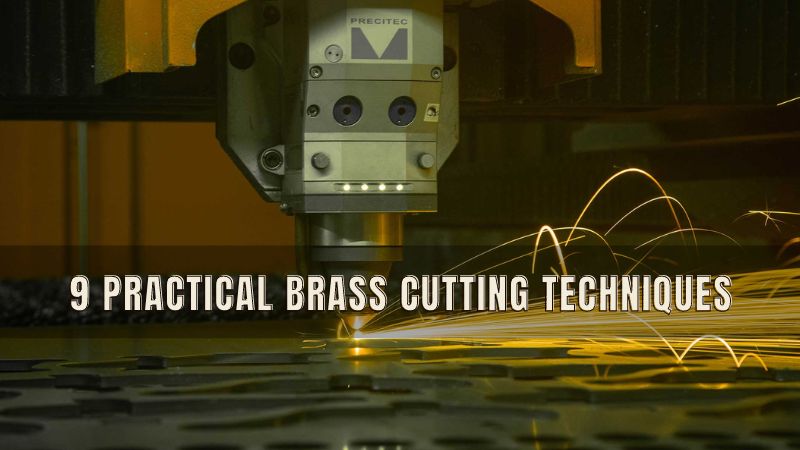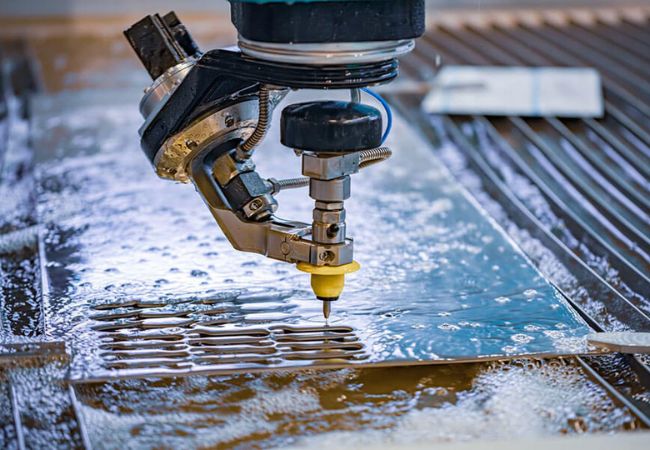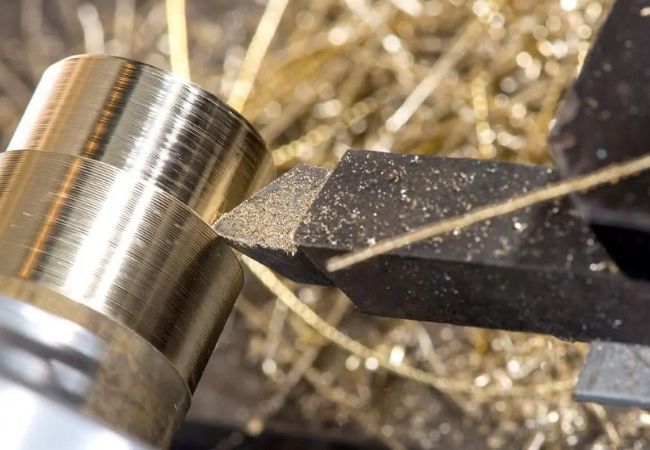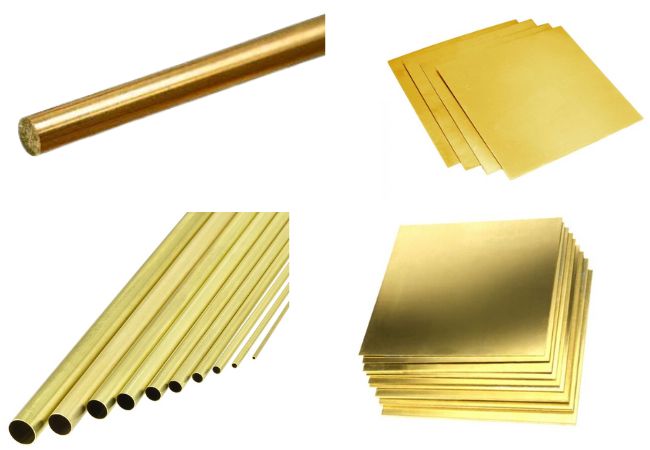
Cutting brass for different fabrication processes may require a many processes and techniques. This article will mostly concentrate on various brass cutting methods.
Let’s dive right in:
1. Laser Brass Cutting
This is a cutting process that utilizes a laser in cutting brass to achieve accurate desired cuts.
Although the process is non-contact, pressure and heat are used exclusively to produce the cutting motion.
Brass Cutting Tools
- As they create high-quality cuts, fiber lasers are employed in this method to achieve accuracy and steady production processes.
- CO2 lasers, they use gas mixtures with carbon dioxide as their main component and are electrically stimulated.
How the Process Works
- The laser resonator emits a beam of light that is reflected by mirror systems and directed to the cutting head. Where the laser emerges from is where the laser’s resonator is located.
- A focus lens located at the cutting head aids in producing a laser beam that is exceedingly narrow and concentrated. The brass substance that needs to be sliced is then the focus of the tiny, focused beam of light.
- Chains or belts are used to power the mechanical system known as the XY gantry, where the cutting head has been mounted. This system’s motion guarantees that the cutting head moves correctly across the work surface.
- With the help of the XY gantry system, the laser head may move around the work surface and make the desired cuts in various directions.
- For a precise cut, the brass material should be the focal point of the lens, where the laser is most effective. Hence, the focusing process is crucial to enabling the laser to make accurate cuts.
Advantages
- This approach is precise because it provides excellent precision levels when compared to other thermal cutting techniques for brass.
- Flexibility is accomplished because the technique does not call for changing tools when cutting brass that has the same diameter and thickness.
- Speed; because this method of cutting brass is quicker than others, including plasma cutting, it is more efficient.
- The non-contact cutting makes the procedure cost-effective. Because of this, there is no mechanical friction to cause tool wear.
- Because the machine is automated, labor expenses are reduced because only one machine operator is needed to complete duties.
Disadvantages
- While cutting thick brass plates, laser brass cutting loses its accuracy. Plates are only cut with the laser down to 10 mm.
- Once the material has melted, the laser cutting releases hazardous fumes and vapors that are harmful to health
- In order to reach precise cut standards, this procedure necessitates the use of trained employees.
- A laser brass cutting machine is pricey compared to other methods since it requires a large initial investment.
Applications
Brass laser cutting is applied in the following industries;

Laser Cut Brass Parts
- Production of jewelry
- For decorative purposes
- Fabrication of bicycles
- They are used in architecture
- They are used in the making of furniture
- They are used in computing
More Resources:
Sheet Metal Brass Fabrication – Source: KDMFAB
Brass – Source: Wikipedia
2. Cutting Brass with Saw

Cutting Brass with Saw
This is the process of cutting brass by the help of metal saws. Depending on the type of saw, it should be having metal blades to prevent it from dulling.
Brass Cutting Tools
- Slitting saws
- Band saws
- Circular saw blades
- Cutoff wheels
How the Process Works
- The process starts with measuring and locating the brass’s cutting points.
- The brass item is then placed on the work table.
- The saw blades are properly adjusted to cut the brass.
- Starting the cutting process, the saw is carefully steered to make precise slices.
- The saw is stopped once the targeted locations have been cut through.
Advantages
- The excellent saw features, such as the rip fence, enable straight cuts on the brass materials, leading to accuracy.
- These cutting saws produce more goods because they operate more quickly and with less energy.
- Because the blades have a sharp edge that enhances precise cuts on the brass material, there is no material waste.
- Since the blades are durable and strong, the edges stay sharp for a long time, leading to the development of finer finishes.
- The saws are inexpensive and generally accessible, which accounts for their low acquisition cost.
Disadvantages
- The saws are only used for little tasks because they are too small to be utilized for larger ones without damaging the blades.
- These saws don’t cut as straight as fabricators would like because of the severe vibration that occurs during the sawing procedures.
- These saws don’t have a cabinet to protect the motor, so they generate noise pollution that harms the environment.
Applications
Cutting of brass with saw is applied in the following;
- Decoration
- Making of musical instruments
- Architectural trimming
More Resources:
Cutting Brass – Source: Cabaret
How to Cut Brass– Source: Yard & Garden Guru
3. CNC Brass Cutting
CNC Brass Cutting is a procedure that uses preprogrammed computer software to cut brass.
The entire procedure is controlled by the preprogrammed software.
Brass Cutting Tools
The following are some of the tools used in CNS brass cutting:
- Since end mills have cutting flutes on their sides and ends, they are used in this process.
- With fly cutters during the cutting of brass, the cutting tools move along in a clockwise direction.
- When cutting brass, they enlarge the existing holes by using reamers, which enhances the surface finishes.
- Face mills create a smooth surface on the brass during the cutting process.
How the Process Works
- An uncut brass work piece, a user, and cutting are required for the operation of this CNC brass cutting machine.
- The operator then employs a computer-aided manufacturing software in addition to the computer-assisted design software. These two programs are utilized to set up a cutting design program for various elements.
- The design program is then translated into a G-code, which is a language that is only understood by the machine. The exported vector file to the machine improves the conversion of this language.
- By doing this, the program is able to finish the cutting phase of the complete production process.
Advantages
- Since the machine runs quickly, short lead times are possible.
- The brass cutting machine is dependable and provides high-quality cut brass with a minimal amount of waste.
- The machine is adaptable since the cutting tools and brass can be sliced into a variety of shapes and forms.
- When compared to other cutting techniques, such as manual procedures, this technique for cutting brass is more accurate.
- The machine is economical since it lowers labor costs and produces goods quickly.
- Complicated machined parts are produced, which is harder to do with other manual machining techniques.
Disadvantages
- When the brass surface is rough, the machine’s precision can occasionally be poor, which corrupts the cutting accuracy.
- This brass cutting procedure is more expensive when there are high production rates since it needs more money.
- The machine only needs competent personnel to run, thus only someone with proper training should operate it.
Applications
The CNC brass cutting machine is used in cutting brass which is used in the following;
- Manufacturing of ammunition components
- Making of connectors and fasteners used in fittings
- It is used in the automotive and aerospace industry to make appliance parts.
More Resources:
CNC Cutting vs Laser Cutting – Source: H. LOEB
Brass CNC Machining – Source: ECOREPRAP
4. Cutting Brass with Rotary Tools

Cutting Brass Parts
This is a brass cutting tool comprising of a handle and a circular blade.
Brass Cutting Tools
- Carbide cutters, sanding drums, high-speed cutters, and engraving cutters are some of the tools used to engrave and carve brass.
- We have drill bits available for drilling brass.
- Keyhole and groove router bits are just a couple of the tools utilized in the process of routing brass.
How the Process Works
- The procedure involves rotating the brass material as it is being moved at high speeds along rollers.
- This allows the saw blade to cut through the brass material’s thickness.
- There is no material waste because only one saw blade is used throughout the process and it does not remove any chips.
Advantages
- The regularity of the cut is achieved because the cuts on the brass material are consistent.
- The brass machinability process uses a faster production speed and accuracy, both of which lead to efficiency.
- There is no waste created throughout the cutting processes, which reduces production costs and benefits the environment.
- When compared to other brass cutting machines, these devices have an affordable initial investment cost. As a result, buying the machine is simple.
Disadvantages
- The size ranges that can be worked with by this brass cutting technique are restricted. Height, length, and width all affect size ranges.
- This approach is not suited for cutting thicker brass materials or for demands for large tonnage.
Applications
This process of brass fabrication is applicable in the following;
- Cutting of brass materials used in locomotives.
- Making of brass conveyors
- Brass cylinder manufacturing
- Making of brass game equipment
More Resources:
Grinding – Source: Wikipedia
5. Plasma Cutting Brass
Because brass is a conducting metal, this method of cutting brass can cut through it. Using this method, brass material of any thickness can be sliced.
Brass Cutting Tools
These cutting tools include;
- A plasma cutter that utilizes electric arcs that cut through the brass materials hence easy manipulation.
- Hand held plasma torch
How the Process Works
- Plasma cutters force an electric pilot arc through a small gas-filled aperture. It may be nitrogen, oxygen, or argon, among other gases, depending on the gas used.
- By using this method, the gases can be heated to a higher temperature where they can transform into plasma.
- At this point, a circuit is being created with the brass metal since the plasma is an electric conductor. The brass substance is then sliced by the plasma arc as a result of this.
Advantages
- Due to its high speed rates, brass fabrications are done very fast.
- When accuracy is a priority, this method delivers error free cuts therefore considered highly accurate.
Disadvantages
- Since the method results in V-shaped cuts when cutting thicker brass materials, it is not optimal.
- It produces a lot of noise pollution, which has a negative impact on the environment and is a source of noise pollution.
- This production technique results in deformation for thin brass metal thickness. Moreover, cutting thicker metals demands a larger power source, which raises production expenses.
Applications
This brass fabrication method is mainly use in the following processes;
- Automotive fabrication and repairs
- Brass industrial restorations
- Making of brass designs in industrial constructions
More Resources:
Plasma Cutting – Source: Wikipedia
How to Plasma Cut Brass – Source: Piping Mart
6. Waterjet Cutting Brass
Waterjet cutting is a technique for slicing through brass metals that makes use of large, high-pressure water streams.
Brass Cutting Tools
- It has a pump that is in charge of applying great pressure to the water.
- After the brass material has been cut, the water tank is filled with water and releases its energy.
- Here, water at high pressures and abrasives are passed into the cutter heads.
- The cutting surface offers a cutting platform with clamping pieces so that precise measurements can be achieved.
- The gantry’s role is to control the movement of the cutting head.
How the Process Works
- Rapid water transportation is accomplished by a pump.
- The accumulator receives water from the intensifier, where it is transferred and briefly stored under high pressure.
- The high pressure water that was previously in the accumulator is now fed through a control valve.
- After that, energies shift, and the high velocity produces kinetic energy.
- The water flow rate must be under control and directed to the nozzle via the flow regulator.
- The result is the production of high water velocities that are then directed towards the brass workpiece through the nozzle.
- Since the kinetic energy must then be transferred into pressure energy, the brass material is then subjected to high pressures.
- The brass material may shatter as a result of the high pressure energies, necessitating the removal of this particular component.
- Water is subsequently used to remove the gathered material.
Advantages
- The brass material does not deform despite the high water pressures; instead, its original shape is preserved.
- The procedure has the ability to cut the brass material intricately and intricately.
- Working surfaces are not harmed because the procedure produces no heat while it is running.
- It is more environmentally friendly because no pollution of any type is produced.
- Accuracy levels are really high.
Disadvantages
- With this cutting process, it takes longer times hence brass fabrication will take longer.
- Unreliability, from time to time, the machine breaks down thus leading disruption in cutting and delayed productivity processes.
Applications

Waterjet Cutting Brass
This application is used in brass fabrication in the following;
- In the manufacture of military equipment with executions that include shaping and amour plating
- The brass fabrication is also used in circuit boards.
- Marine industry
- Aerospace industry
- Automotive industry
- Architectural trims
More Resources:
Waterjet Cutting – Source: Wikipedia
7. Drilling Brass
It is a cutting process where a circular hole is created on the brass material using a drill bit.

Drilling Metal
Brass Cutting Tools
In the drilling process of brass, a drill bit is used to cut through the material.
How the Process Works
Below is the process to drill a brass material;
- Drill bits with the necessary dimensions must be present.
- You must put on safety glasses and gloves for your own protection.
- The brass metal requires clamping on the workbench.
- Once marked, the fabrication point is next.
- By the help of center punch, a dent should be made on the brass material to prevent the drill bit from slipping.
- For easier drilling, oil has to be applied to ease the drilling processes.
- The clamp’s brass substance is next drilled at a constant speed.
- The drill bit is removed after a successful drilling operation and is then reversed.
- Finally, a deburring tool is used to remove any sharp edges left over from the entire drilling process.
Advantages
- The drill bits can be used with this drilling technique to drill through thicker brass materials.
- High accuracy is attained through the precise marking of the drilling spots and the use of a lubricant during the drilling procedures.
- It is simpler and involves the least amount of effort to drill a hole in the brass material.
Disadvantages
- Long drilling sessions run the risk of damaging drilling bits.
- It’s possible that the drills will occasionally overheat.
- The technique can occasionally be unreliable, fracturing as it is being carried out.
Applications
Brass drilling applications takes place in the following industries;
- In the automotive industries
- Medical industries
- The construction industries
- Electronic industries
More Resources:
How to Drill Metal – Source: Wiki How
8. Milling Brass
This is a method of machining that removes a certain part of brass material from its work piece.

Cutting Brass Rod
Brass Cutting Tools
Milling cutter machine
How the Process Works
- Basically, after the needed brass workpiece has been fed against the rotary cutter, the cutting process happens.
- The cut depth, rotation speed, and rotation direction are the process determinants. The optimum outcomes of the metal production are produced by properly adjusting these parameters.
- The work item will now be displayed in various ways as the cutter rotates at high speeds.
- In order to achieve the desired shape, the teeth will eliminate these components.
Advantages
- Using this production method has comparatively minimal costs.
- This approach requires less time to produce brass fabrication.
- Given that it is possible to generate a variety of desirable forms, this process has a large manufacturing capacity.
Disadvantages
- The initial outlay for purchasing the cutting material is substantial.
- The brass work surface requires post-fabrication operations, which are more expensive.
Applications
- Designing of brass custom fasteners
- Creation of three dimensional shapes
More Resources:
Milling Brass – Source: The Piping Mart
Milling – Source: Wikipedia
9. Cutting Brass with Pliers
This is the cutting of a brass work piece by the use of pliers.

Cutting Brass Sheet
Brass Cutting Tools
Pliers
How the Process Works
- The cutting place on the brass mass material has to be identified.
- This exact point should lie between the jaws of the pliers.
- After this, a compressing is applied on pliers’ handles thus resulting on the cutting of the brass workpiece.
Advantages
- A plier is not expensive therefore it only requires few funds when purchasing it.
- When sharp, it accurately makes a cut on the working surface.
Disadvantages
- It is limited to material sizes since large brass material cannot be cut by using a plier.
- This type of fabrication can only be done on small scale.
Applications
The process is used in the cutting of brass material used in;
- Automotive industry
- Construction industry
- Aerospace industry
Brass Cutting Tips and Tricks
- To maintain safety, always wear a protective gear.
- The right machine and cutting tool should be chosen for brass fabrication.
- Putting in mind different machining factors, for better results, the correct technique should be chosen.
- You need to understand when portability is preferred.
- Choosing the most appropriate brass machining to save costs and achieve efficiency.
Forms of Brass Materials You Can Cut

Forms of Brass Material
| Brass Form | Comments |
| Cutting Brass Tube | This procedure calls for the use of a tubing cutter or a saw. |
| Cutting Brass Sheet | Metal snips and shears are used to cut brass sheet. A hacksaw can also be used to accomplish the task. |
| Cutting Brass Rod | Rods of brass can only be cut efficiently by ether using a cutting saw or pliers. |
| Cutting Brass Bars | A hacksaw should be used when cutting brass bars. |
| Cutting Brass Block | A hacksaw should be used when cutting brass blocks. |
Quick FAQs
Which Blade do your use in Brass Cutting?
The blades to use when cutting brass are carbide-tipped blades
Can a Grinder Cut Brass?
No, a grinder is not advisable to cut brass since the process is hazardous and may explode.
Do Brass Cutting Require Cooling Fluids?
Yes, cooling fluids are required for easier cutting and extending the cutting tool life.
Conclusion
As you can see, you can use many technique to cut brass materials.
Additionally, their working principles, advantages, disadvantages and applications have been looked at.
Moreover, it is evident that brass metal can be used in wide ranges of applications that involve manufacture, repair and designs.
For all your brass cutting needs, contact us now.
Related Resources:
Engraving on Brass – Source: KDM




